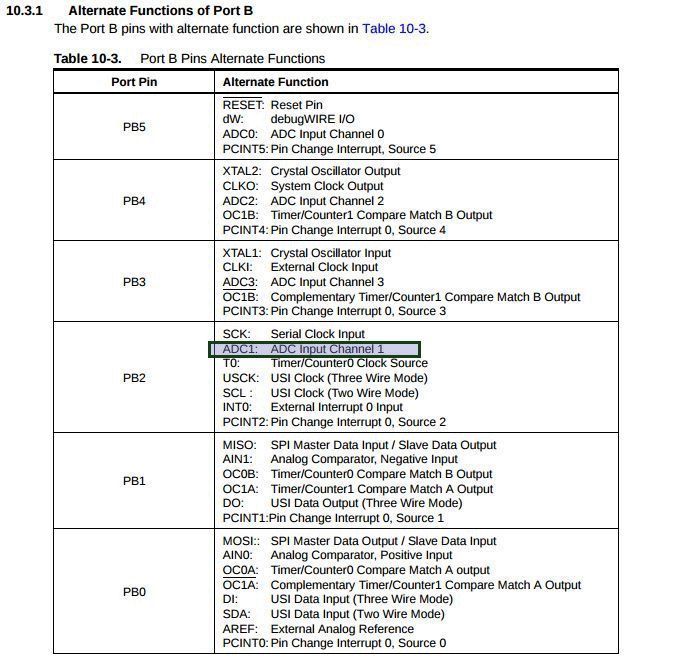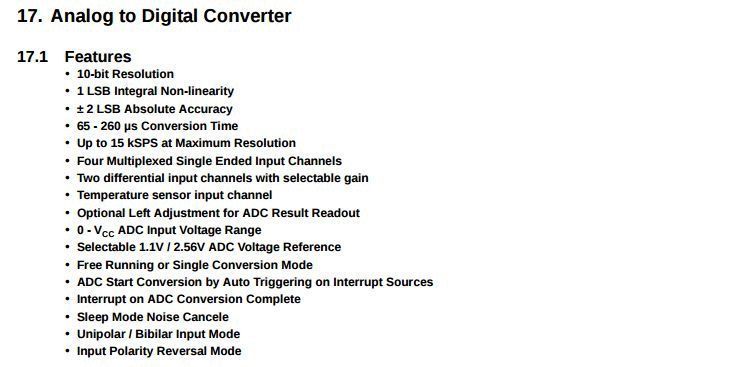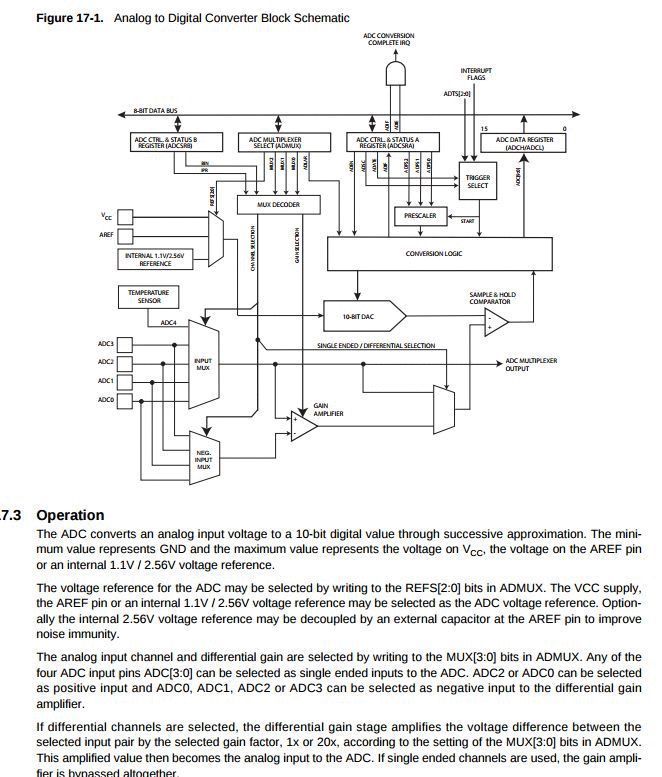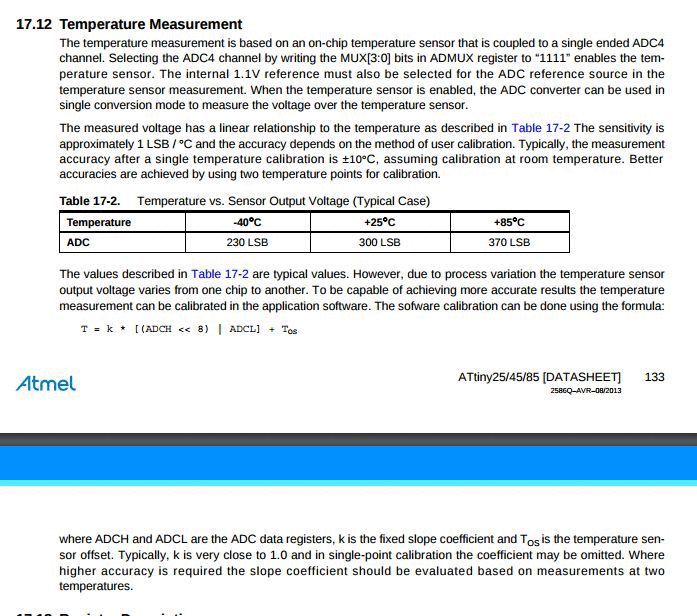
Greetings, here lies my work-log at
______ _ ___ _ _____ _____ __ ______ | ___| | | / _ \ | | / __ \| _ |/ | |___ / | |_ __ _| |__ / /_\ \ ___ __ _ __| | ___ _ __ ___ _ _ `' / /'| |/' |`| | / / | _/ _` | '_ \| _ |/ __/ _` |/ _` |/ _ \ '_ ` _ \| | | | / / | /| | | | / / | || (_| | |_) | | | | (_| (_| | (_| | __/ | | | | | |_| | ./ /___\ |_/ /_| |_./ / \_| \__,_|_.__/\_| |_/\___\__,_|\__,_|\___|_| |_| |_|\__, | \_____/ \___/ \___/\_/ |_|
sensors galore, for this week - i wanted to try as many sensors as possible, due to limited time, at the end I managed to design and stuff a hello.world.DHT22 sensor attiny45 based board. I also designed a board called hello.sniffer which is an attiny44 based gas sensor board


The pinout diagram from the datasheet is what I used to pick the digital pin I needed to be the ADC (Analog to Digital Converter)
I selected PB2 - it is a general I/O port and the description is as follows

While doing ADC , it is generally recommended to use an external clock for better accuracy, so i looked into the clock systems mentioned in the datasheet, but however later decided to try the board on the internal clock first, to see how much the internal clock's inaccuracy affects the readings

I used arduino libraries and the arduino IDE to program the board - the command to intitialize Analog reading is 'analogRead'
define tempPin A1 //Defining the pin A1 as the data pin
int val;
void setup()
{
myserial.begin(9600); //serial begins at 9600 baud rate
pinMode(A1, INPUT); //pin A1 becomes an input now
}
void loop()
{
val = analogRead(tempPin);
float mv = ( val / 1024.0) * 5000; //mapping analog values to relevant temperature readings
float cel = mv / 10;
float farh = (cel * 9) / 5 + 32; //farh to cel conversion
myserial.print((char)cel);
delay(10);
}
ALl the alternate functions of each pin, the one I need is a pin with ADC

Details on how to toggle pins to different states

Basic overview of ADC features of an ADC pin

This is the block diagram of the ADC, fascinating stuff

The chip has an in-built temperature sensor but it can't be put to service as a temperature sensor like LM35


This is the pproject home of this design, the file tree shows the library cache, the netlist, the schematic and the PCB design

This is the CvPCB window where all the components you have added to your schematic will need to be assigned footprints here

After assigning footprints, one has to generate the netlist and then read that netlist in PCBnew - which is the PCB layout software

This is the final schematic

This is the final PCB footprint layout with traces

invoking the compiled version of FabModules

Selecting the 1/64 profile to mill traces

Selecting the 1/32 profile to cut edges


Milled boards :)
View post on imgur.com


Used arduino Uno as ISP
#include
// Example testing sketch for various DHT humidity/temperature sensors
// Written by ladyada, modified for integer use, public domain
#include "TinyDHT.h"
#define DHTPIN 2 // DHT connected to Arduino Uno Digital Pin 2
// Uncomment whatever type you're using!
//#define DHTTYPE DHT11 // DHT 11
#define DHTTYPE DHT22 // DHT 22 (AM2302)
//#define DHTTYPE DHT21 // DHT 21 (AM2301)
// Connect pin 1 (on the left) of the sensor to +5V
// Connect pin 2 of the sensor to whatever your DHTPIN is
// Connect pin 4 (on the right) of the sensor to GROUND
// Connect a 10K resistor from pin 2 (data) to pin 1 (power)
// of the sensor
DHT dht(DHTPIN, DHTTYPE);
SoftwareSerial mySerial(10, 11); // RX, TX
void setup() {
mySerial.begin(9600); // Output status on Uno serial monitor
mySerial.println("DHTxx test!");
dht.begin();
}
void loop() {
// Reading temperature or humidity takes about 250 milliseconds!
// Sensor readings may also be up to 2 seconds 'old' (its a very slow sensor)
int8_t h = dht.readHumidity();
int16_t t = dht.readTemperature(1);
// check if returns are valid then something went wrong!
if ( t == BAD_TEMP || h == BAD_HUM ) { // if error conditions
mySerial.println("Failed to read from DHT");
} else {
mySerial.print("Humidity: ");
mySerial.print(h);
mySerial.print(" %\t");
mySerial.print("Temperature: ");
mySerial.print(t);
mySerial.println(" *C");
}
delay(2000);
}
A point to note is that the standard DHT library is too big with the software serial library to fit in the flash memory of the attiny40s, so, I've used anpother variant of the lbrary called TinyDHT which uses int values instead of heavier float values
But alas the sensor turned out to be faulty (i'm to blame mostly) :/
My DHT22, I suspect is whack after I've handled it roughly; so I decided to replace it with an LM35 temperature sensor
with similar pinouts, I resorted to using the same board for the LM35 sensor.


#include //library to replace hardware serial
SoftwareSerial myserial(3, 4); // TX and RX pins (transmit and recieve)
#define tempPin A1 //Defining the pin A1 as the data pin
int val;
void setup()
{
myserial.begin(9600); //serial begins at 9600 baud rate
pinMode(A1, INPUT); //pin A1 becomes an input now
}
void loop()
{
val = analogRead(tempPin);
float mv = ( val / 1024.0) * 5000; //mapping analog values to relevant temperature readings
float cel = mv / 10;
float farh = (cel * 9) / 5 + 32; //farh to cel conversion
myserial.print((char)cel);
delay(10);
}
A whole world of sensing possibilities. :o
Gotta gather all the data i can . :o